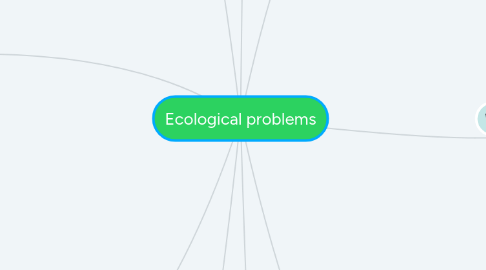
1. Global warming
1.1. Causes
1.1.1. Greenhouse effect
1.1.2. Deforestation
1.1.3. Ozone Depletion
1.1.4. Water Vapour
1.1.5. Burning of Fossil Fuels
1.2. Consequences
1.2.1. Climate change
1.2.2. Extinction
1.2.3. Melting of the poles
1.2.4. Rising sea level
1.3. Solutions
1.3.1. Change up to renewable sources of energy
1.3.2. Buying recycled products
1.3.3. Less driving
1.3.4. Keep devices switched off
1.3.5. Using less hot water
1.3.6. Use public transportation
1.3.7. Planting trees
2. Animal Extinction
2.1. Causes
2.1.1. Loss of habitat
2.1.2. Overharvesting
2.1.3. Pollution
2.1.4. Introduction to Invasive Species
2.1.5. Climate change
2.2. Consequences
2.2.1. Losing biodiversity
2.3. Solutions
2.3.1. Eat less meat
2.3.2. Recycle and buy sustainable products
2.3.3. Give your time to nature
2.3.4. Join an organization
3. Water Pollution
3.1. Causes
3.1.1. Industrial process
3.1.2. Industrial waste
3.1.3. Urbanization
3.1.4. Oil spills
3.1.5. Garbage
3.2. Consequences
3.2.1. Less clean water for agriculture
3.2.2. Water becomes dangerous to drink
3.2.3. Economic costs:
3.2.4. Water-borne diseases
3.2.5. Acidic rain
3.2.6. Genetic mutations
3.3. Solutions
3.3.1. Stop using harmful chemicals at home
3.3.2. Recycle
3.3.3. Sewage treatment
3.3.4. Prevent industrial waste reaching water
3.3.5. Avoid using paper bags
3.3.6. Go organic
4. Fires
4.1. Causes
4.1.1. Burning Debris
4.1.2. Unattended Campfires
4.1.3. Cigarettes
4.1.4. Fireworks
4.1.5. Arson
4.2. Consequences
4.2.1. Animal extinction
4.2.2. Air pollution
4.2.3. Animals lose their lives
4.2.4. Trees and plants are gone
4.2.5. health problems
4.3. Solutions
4.3.1. Following all of the laws
4.3.2. Light fires in easily controlled areas
4.3.3. Do not burn combustible materials
4.3.4. Put a cigarette out completely
5. Deforestation
5.1. Causes
5.1.1. Agricultural Activities
5.1.2. Logging
5.1.3. Urbanization
5.1.4. Forest Fires
5.1.5. Desertification of land
5.2. Consequences
5.2.1. Climate Imbalance
5.2.2. Wildlife Extinction
5.2.3. Floods
5.2.4. Soil Erosion
5.2.5. Increase in Global Warming
5.3. Solutions
5.3.1. Reforestation
5.3.2. Land Use Planning
5.3.3. Use of High-Yield Variety Seeds
5.3.4. Monitoring
6. Air Pollution
6.1. Causes
6.1.1. The burning of fossil fuels
6.1.2. Agricultural activities
6.1.3. Exhaust from factories and industries
6.1.4. Mining operations
6.1.5. Indoor air pollution
6.2. Consequences
6.2.1. Global warming
6.2.2. Respiratory and heart problems
6.2.3. Acid rain
6.2.4. Effect on wildlife
6.2.5. ozone layer
6.3. Solutions
6.3.1. Save energy
6.3.2. Clean energy production
6.3.3. Eco-friendly transportation
7. Waste Disposal
7.1. Causes
7.1.1. Too mush waste
7.1.2. Urbanization and population growth
7.1.3. Most of the waste is toxic
7.1.4. Regulations are based on vested interests
7.2. Consequences
7.2.1. Air pollution
7.2.2. Ground water pollution
7.2.3. Health effects
7.2.4. Economic costs
7.2.5. Landfill fires
7.3. Solutions
7.3.1. Recycle, Reuse, and reduce
7.3.2. Effective waste disposal and management
7.3.3. Control and monitoring of land filling
7.3.4. Waste Diversion Plans
7.3.5. Improvements of thermal waste treatment
8. Natural Resource Depletion
8.1. Causes
8.1.1. Overpopulation
8.1.2. Poor Farming Practices
8.1.3. Logging
8.1.4. Pollution
8.1.5. Industrial and Technological Development
8.2. Consequences
8.2.1. Animal Extinction
8.2.2. Water shortages
8.2.3. Oil depletion
8.2.4. Loss of forest cover
8.2.5. Depletion of minerals
8.3. Solutions
8.3.1. Controlling Deforestation
8.3.2. Reducing oil, mineral, and material consumption
8.3.3. Sensitization and awareness creation
8.3.4. Use of renewable sources of energy
9. Urbanisation
9.1. Causes
9.1.1. Industrialization
9.1.2. Commercialization
9.1.3. Social benefits and services
9.1.4. Employment opportunities
9.1.5. Modernization and changes in the mode of living
9.1.6. Rural urban transformation
9.2. Consequences
9.2.1. Housing problems
9.2.2. Overcrowding
9.2.3. Unemployment
9.2.4. Development of slums
9.2.5. Water and sanitation problems
9.2.6. Poor health and spread of diseases
9.2.7. Traffic congestion
9.2.8. Urban crime
9.3. Solutions
9.3.1. Building sustainable and environmentally friendly cities
9.3.2. Creation of more jobs
9.3.3. Population control

